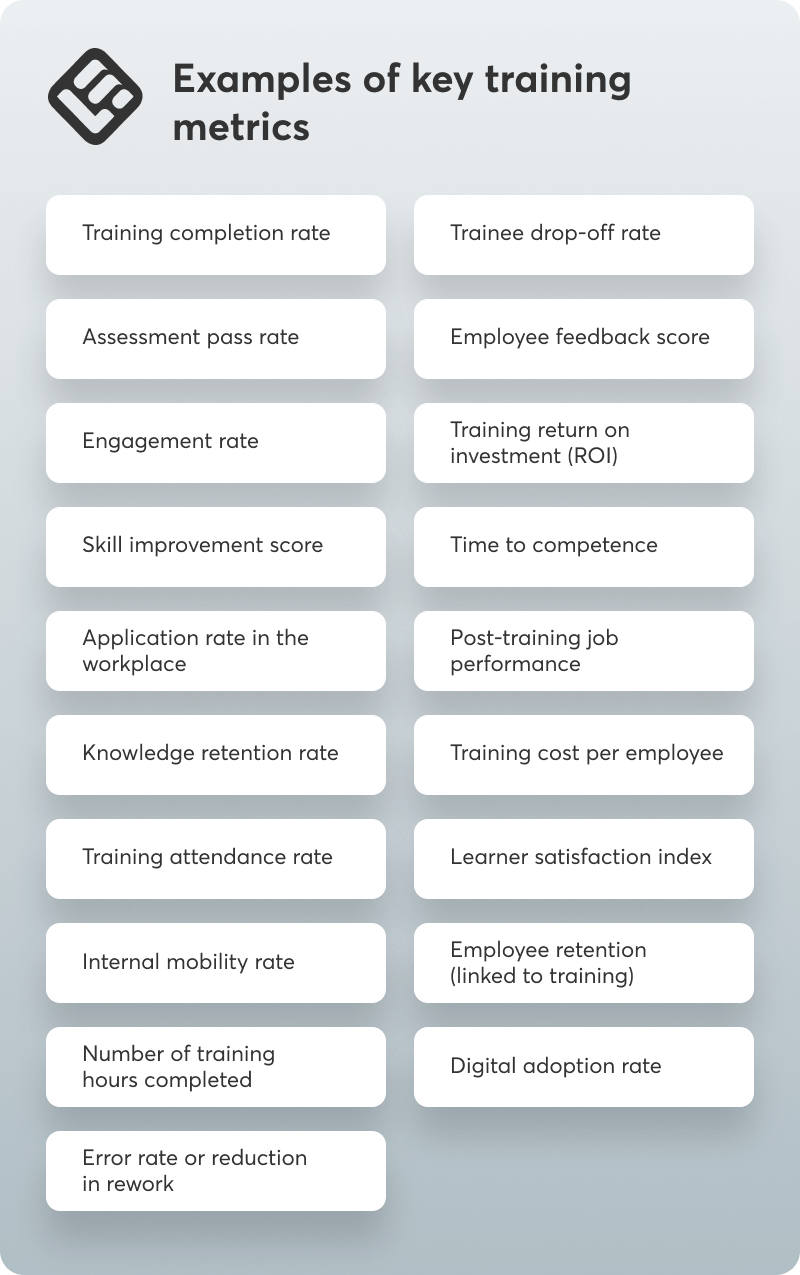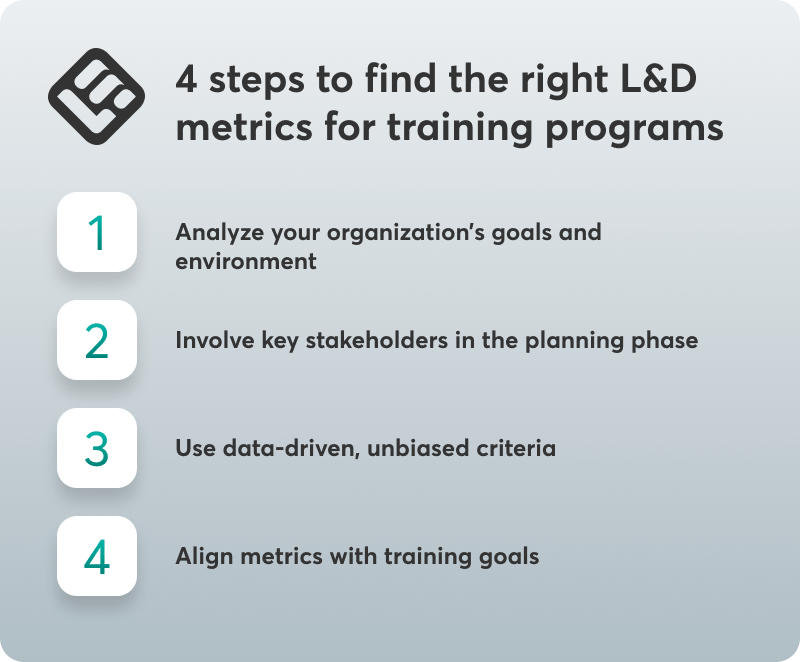Table of Contents
You can run your training course without checking the metrics, but it’ll be like navigating a new city without any sort of map. You can wander, and you might end up somewhere nice, but you might also find yourself spending too much time and money somewhere you don’t want to be.
Employees who take part in personalized training and development programs report higher job satisfaction, and they’re 50% less likely to leave. [1] When you measure what’s happening in your training, you get the insight you need to make it more relevant and worth the time you’re asking people to invest.
Evaluating training effectiveness is essential for understanding how well your programs are working and for identifying areas for improvement. By tracking the right training metrics, you can directly connect your training initiatives to improvements in business performance.
The table above shows you the 19 most important training metrics you should be tracking, what they measure, and why you shouldn’t ignore them.
What are training metrics?
Learning and development metrics tell you how your training program is performing. They can show you things like whether learners complete their courses, how they’re doing on assessments, and whether they’re practically applying what they learn.
Some metrics focus on things like learner progress or engagement. Other metrics look at impact like whether the training helps with employee retention or supports career growth. You’ll see metrics demonstrated as numbers, sometimes with charts and graphs, and they can be as simple as the number of attendees or as complicated as return on investment (ROI).
No matter their form or function, they help you measure the effectiveness of your online course.
Why should I use metrics for evaluating training and development?
Without metrics, you’re left to guess what’s working and what isn’t. Even with direct learner feedback, you’ll lack objective, hard facts. This makes it difficult to improve your course and nearly impossible to measure effectiveness.
Simply put, tracking and reviewing analytics tell you what’s working and what isn’t. Analytics and reports show you a direct path to improvement, so you know where to invest your time and money in changes.
19 training metrics examples
No single number will tell you how your training is doing—you need a mix of the right metrics for true clarity. These are often available through your training learning management system (LMS).

Which metrics you focus on will depend on your goals, which may change over time. But here are the 19 metrics for evaluating training and development that I think deserve your attention.
1. Training completion rate
Training completion rate is simple to track and tells you how many people finish the training they start. A low rate might mean the course is too long or not relevant, and a high rate tells you that learners are sticking with it til the end.
Completion may be simple, but when folks are bogging down after module two, then either the course is too long or it is missing. I was employed at a company in which only 58 percent of employees completed compulsory training. With a reduction of course length and Slack reminder messages, the next month’s completions increased to 91 percent. Time to complete will inform you whether the material can be covered during a regular workday or personnel are taking it in between activities. When the average time blows out of proportion, then it is a sign of bloated or unclear content.
You can track training completion rates easily using user progress reports in your LMS.
2. Trainee drop-off rate
This metric is closely related to completion rates, but it’s more specific. If learners are dropping the course, this metric shows you exactly where that’s happening. You can see if it’s somewhere around the middle or end, or—yikes—if it’s right at the beginning.
Knowing where learners leave the course helps you pinpoint the problem area and can show you if you need to improve something like content or pacing. Trainee drop-off rate can be especially helpful if you’re testing new content or formats.
3. Assessment pass rate
Pass rates show you if your learners understand the material. If most learners fail, for example, your content might not be clear or your exams might be too difficult. If everyone passes with high scores, you might want to consider making the tests a little tougher.
4. Employee feedback score
Employee feedback scores are often gathered through post-training surveys. By gathering learners’ feedback, you can gain direct insight into how they felt about the course.
Using a combination of closed, scored questions and open-ended comments can help give you a complete picture to work with.
5. Engagement rate
Engagement rate measures how actively learners interact with your content. It checks things like clicking through slides, watching videos, answering questions, and joining discussions.
When people are engaged, they learn better and remember more, so the clearer your understanding of what makes learners click, the better. Low engagement might signal that your content isn’t resonating or that it needs better interactivity. High engagement shows you’re on the right track.
6. Training return on investment (ROI)
This metric is a key one for stakeholders, as they may want to know exactly how training budgets are paying off. Training ROI compares what you spend on training to the value it creates.
Training ROI could look like better performance, fewer errors, faster onboarding, or higher employee retention.
7. Skill improvement score
By testing skills before and after training, you can measure learners’ skill improvement scores. It’s a direct way to check if the training really helps learners get better at what they do. And while you can certainly use it to test hard skills, you can use it to measure soft skills too.
💡 Read also: The top 10 ways to enhance soft skills with employee training
8. Time to competence
This metric is particularly good at showing how long it takes someone, like a new hire, to reach full productivity in their role. It’s useful for onboarding training programs or job-specific training. The shorter the time to competence, the faster learners are able to contribute to the organization.
To measure time to competence, you need to define what “competence” means for each role and how long it takes a learner to get from day one to that point of competence.
9. Application rate in the workplace
Training doesn’t mean much if people aren’t using what they learn. Application rate in the workplace checks how often trainees use new knowledge or skills on the job and ties together training content and day-to-day work behavior.
To measure this, you can use follow-up surveys, manager check-ins, or performance observations after the training ends.
10. Post-training job performance
This is similar to application rate in the workplace, but looks more specifically at a person’s performance and whether it improves after training. Does a salesperson close more deals? Does a support agent close more tickets?
Performance improvement is the most important thing to monitor, as it is connected directly to your key performance indicators (KPIs). It is where the rubber hits the road, where the information gathered in your training activities speaks about its progress in your actual business. After you have invested time and resources in a training program, unless it results in a measurable enhancement in the performance of the employees on your team, then that program is not the most effective, even though the content may be pretty interesting.
Post-training job performance is best measured over weeks or months and compares performance data from before the training to after.
11. Knowledge retention rate
We’ve all been able to pass a quiz right after learning the content, but what about a week, a month, or a year later? Knowledge retention checks how much information your learners hold onto and for how long.
You can track this with follow-up assessments after the training has ended. If scores drop sharply, that can show you that you might benefit from using microlearning or more repetition in your training modules.
12. Training cost per employee
The training cost per employee shows you what you are spending on training per learner. This includes costs like course creation, tools, instructor time, and learner hours. This metric tells you whether the investment you’re making per person makes sense and whether it’s worth the results you’re getting.
If you have rising costs but poor training outcomes, it may be a sign that you need to make some adjustments.
13. Training attendance rate
Who’s showing up for live sessions or scheduled workshops? If you often have instructor-led training or live webinars, the training attendance rate can be a useful metric to check. A low attendance rate could mean that learners don’t find the content relevant, or that there were communication or timing issues involved.
14. Learner satisfaction index
Using surveys, ratings, and open comments, you can get a sense of your learner satisfaction index. Rather than just a single score, it provides a comprehensive view of how trainees feel about the course.
This metric works best if you track it consistently over time so you can spot patterns across courses and delivery methods.
15. Internal mobility rate
Training can help employees move into new roles within their organization, and the internal mobility rate tracks how often that happens. Having strong internal mobility suggests that your training helps people grow and promotes building talent from within.
This metric is especially useful if you’re investing in leadership training programs or career development paths. When people can see training leading to new opportunities, they’re more likely to engage with it.
16. Employee retention — linked to training
LinkedIn’s Workplace Learning report shows that 93% of organizations say retention is a top concern, and the number one way to address it is by providing learning opportunities. That makes this metric especially useful, as it helps you see whether your learning efforts are influencing retention.
If trained employees are sticking around longer than untrained ones, that’s a strong signal that your program shows support and helps people grow where they are.
17. Number of training hours completed
On its own, this metric won’t tell you much about the effectiveness of a course, but it can give you greater context when combined with other metrics like skill improvement or ROI. The number of training hours completed can also help you compare across teams or departments to see if some are over- or under-trained compared to others.
18. Digital adoption rate
Spending a big chunk of your budget on tools and platforms? This metric can help you see how effectively your employees are adopting those systems before and after training them.
If adoption rates are low after training, it could mean that your course missed the mark, or it could mean that the system isn’t well-suited for certain roles or departments.
19. Error rate or reduction in rework
One of the clearest signs of effective training is fewer mistakes. This metric looks at how often errors happen or how much rework is required before and after training.
This metric is useful in technical or customer-facing roles where accuracy matters. A drop in errors can suggest the training is sticking and being applied correctly on the job.
How do I identify the right learning and development metrics for my training program?
Your choices from the training metrics examples above will depend on your organization’s goals for your training. If you’re focused on onboarding, you’ll want to track time to competence and completion rates. If it’s upskilling, look at skill improvement and feedback.

To identify which metrics are right for your training program, here’s what you can do.
Analyze your organization’s goals and environment
Look at your organization’s needs. Are you growing fast and need to get new hires functioning quickly? Then you may want to track the time to competence and onboarding completion. Are you trying to improve customer satisfaction? Then focus on skill development and post-training job performance.
And think about your environment. If your team is remote and spread across time zones, a metric like live attendance rates may not mean as much as engagement or drop-off rates. The idea is to identify which training metrics fit both your business goals and how your organization operates.
Involve key stakeholders in the planning phase
Training metrics are more useful when the right people are involved early. Managers, team leads, HR, and even individual contributors often have different expectations for what training should deliver. One might care about improving efficiency, another about career development, and another about team morale.
Let’s say your sales leader wants to boost close rates, while your product team is focused on better cross-functional knowledge. The sales team, for example, may focus on key metrics like close rate to measure the effectiveness and ROI of training programs. Bring them in and define which metrics matter to each. This helps you focus your reporting and makes it easier to show value in terms that each group cares about.
Use data-driven, unbiased criteria
Base your decisions on hard data collection: progress reports, skill assessments, behavioral changes, and platform usage. These are trackable and repeatable, and less likely to be influenced by subjectivity and personal bias.
For example, if a course gets glowing reviews but low skill improvement scores or high error rates after training, that’s worth looking into. Something might be missing even if people liked the course.
Align metrics with training goals
Your learning goals for your training programs and how you measure them should be linked. Training objectives and learning objectives should be clearly defined to make sure that your training programs achieve the desired outcomes.
If your goal is to build long-term employee engagement, for example, use employee training metrics like internal mobility rate or employee retention linked to training programs.
Improve employee training tracking with LearnWorlds
Clear, accessible data makes it easier to manage and improve your training programs. And with an employee training LMS like LearnWorlds, you get built-in tools to track the right metrics. Learning management systems like LearnWorlds provide valuable insights for training professionals, enabling you to use data-driven decisions to optimize training programs and improve outcomes.
LearnWorlds also uses AI-powered analytics to help you spot patterns in learner behavior and performance so you can connect training activity to real results.
Think:
See how LearnWorlds can help you improve your training with a free trial today.
Sources
[1] Forbes: Capturing The C-Suite’s Attention With L&D Metrics That Matter
Ciera Lamb
Ciera is a freelance content writer and editor connecting companies with their ideal audiences through blog articles and other online content. She approaches her writing with curiosity and research and enjoys the ever-present learning that comes with being a content writer. She is also an avid scuba diver, an aspiring Dutch speaker, and lover of all things nature.
FAQ
Everything you have ever wondered, but were too afraid to ask...



